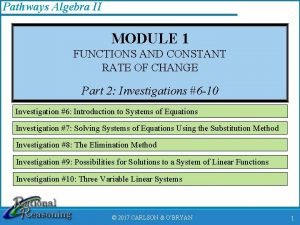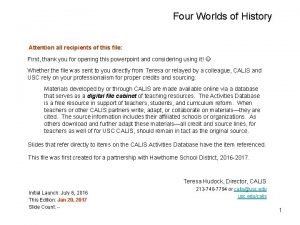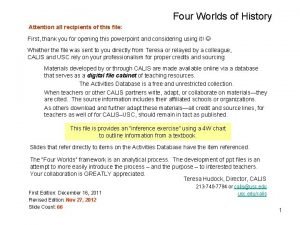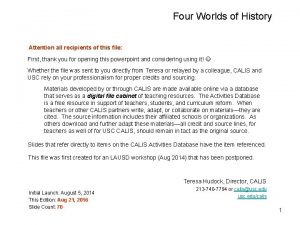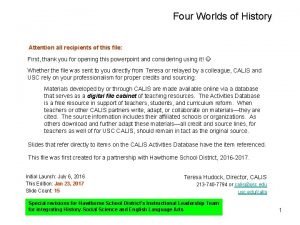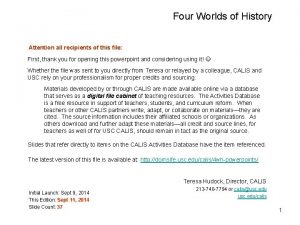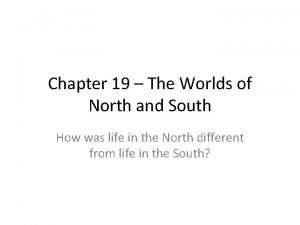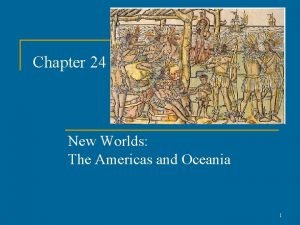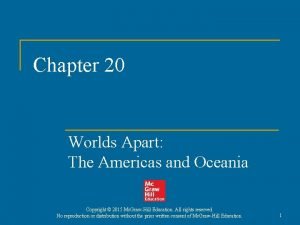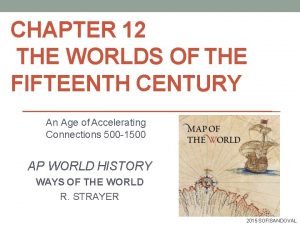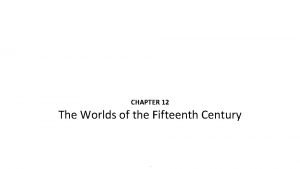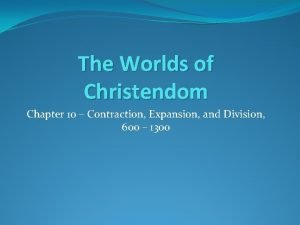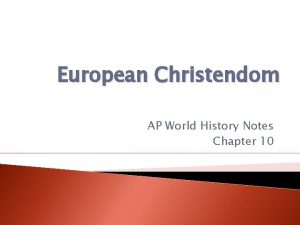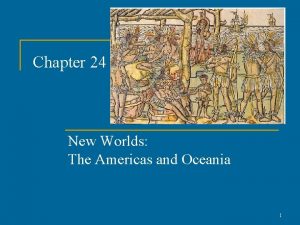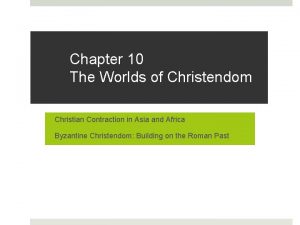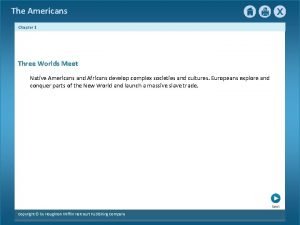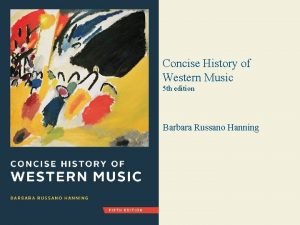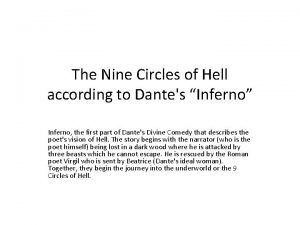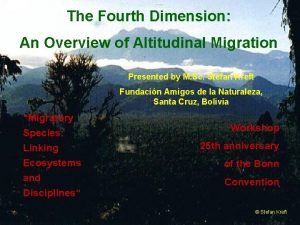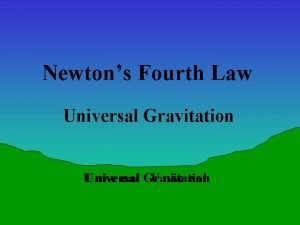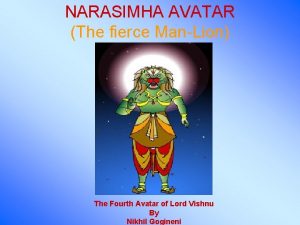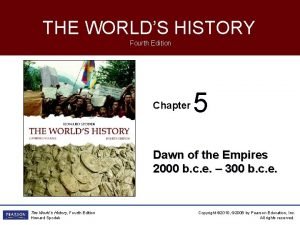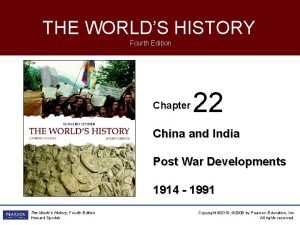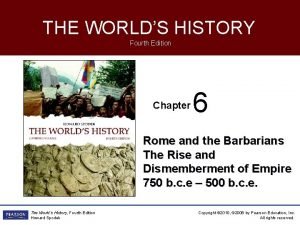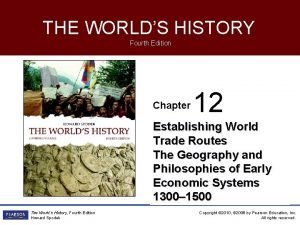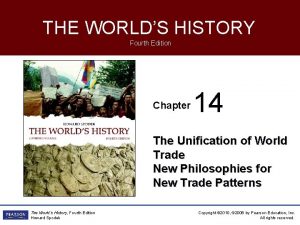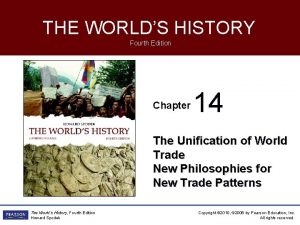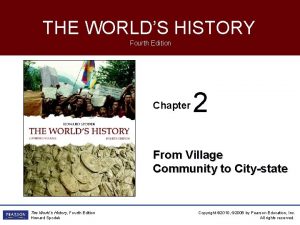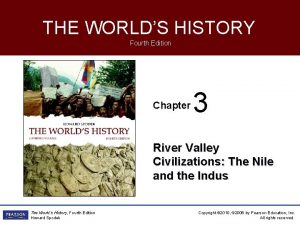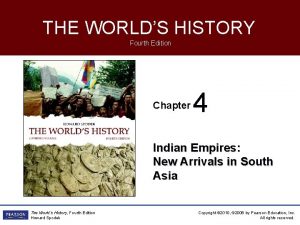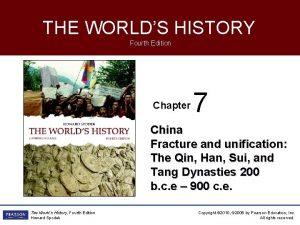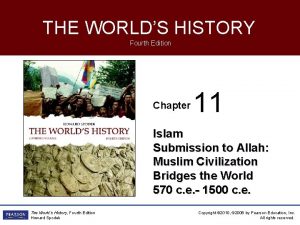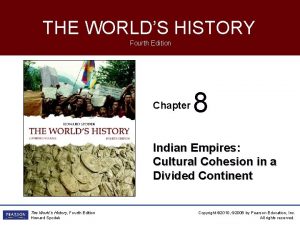THE WORLDS HISTORY Fourth Edition Chapter 1 The


































- Slides: 34

THE WORLD’S HISTORY Fourth Edition Chapter 1 The Dry Bones Speak The World’s History, Fourth Edition Howard Spodek Copyright © 2010, © 2006 by Pearson Education, Inc. All rights reserved.

The Dry Bones Speak • Human Origins in Myth and History – Early Myths § “Myth” is an interpretative story with a moral message that cannot be verified historically § One of earliest myths is Enuma Elish (Mesopotamia), dating to approximately 2000 B. C. E. § Rigveda (India) dates to 1000 B. C. E. § Book of Genesis in the Hebrew Bible § All define creation and the role of people The World’s History, Fourth Edition Howard Spodek Copyright © 2010, © 2006 by Pearson Education, Inc. All rights reserved.

The World’s History, Fourth Edition Howard Spodek Copyright © 2010, © 2006 by Pearson Education, Inc. All rights reserved.

The Dry Bones Speak • Human Origins in Myth and History – The Evolutionary Explanation § Drawn from direct observations from the 18 th century § Relied on the scientific method § The most influential theorists were Charles Darwin and Alfred Wallace § Rejected the simultaneous creation of all species in favor of the cumulative creation of species, which reflected natural selection The World’s History, Fourth Edition Howard Spodek Copyright © 2010, © 2006 by Pearson Education, Inc. All rights reserved.

The World’s History, Fourth Edition Howard Spodek Copyright © 2010, © 2006 by Pearson Education, Inc. All rights reserved.

The Dry Bones Speak • The Evolutionary Explanation – The New Challenges § Changes in species not the result of a grand teleological design with ethical goals but that reflected improved ability to survive and reproduce § Newer organisms that were simply “fit” to survive § These organisms evolved from earlier forms of life rather than as the result of a separate creation § Darwin’s The Descent of Man cements evolutionary explanation in 1871 The World’s History, Fourth Edition Howard Spodek Copyright © 2010, © 2006 by Pearson Education, Inc. All rights reserved.

The Dry Bones Speak • Fossils and Fossil Hunters – The Puzzling Neanderthals § Found in 1856, they were identified as the missing link between humans and ape ancestors § Research suggests Neanderthals made tools and adapted to changing climates § May also have been cannibals § More discoveries showed that Neanderthals were not the missing link The World’s History, Fourth Edition Howard Spodek Copyright © 2010, © 2006 by Pearson Education, Inc. All rights reserved.

The Dry Bones Speak • Fossils and Fossil Hunters – Homo Erectus: A Worldwide Wanderer § Earliest discoveries of this species were in Java and China § Similarities among archaeological finds led to the designation of homo erectus § Few initial ideas of the relationship among the finds led early experts to regard each find as a separate species The World’s History, Fourth Edition Howard Spodek Copyright © 2010, © 2006 by Pearson Education, Inc. All rights reserved.

The World’s History, Fourth Edition Howard Spodek Copyright © 2010, © 2006 by Pearson Education, Inc. All rights reserved.

The World’s History, Fourth Edition Howard Spodek Copyright © 2010, © 2006 by Pearson Education, Inc. All rights reserved.

The Dry Bones Speak • Fossils and Fossil Hunters – The Search Shifts to Africa § Louis Leakey made a major breakthrough in understanding based on skeletal findings in the Olduvai Gorge in East Africa (after 1959) § Studies now involve paleoanthropology, the study of the tools, species and plants included in the locale of each find The World’s History, Fourth Edition Howard Spodek Copyright © 2010, © 2006 by Pearson Education, Inc. All rights reserved.

The Dry Bones Speak • Fossils and Fossil Hunters – Homo habilis § Name means “handy person” § Existed 1. 5 million to 2. 5 million years ago § Possessed opposable thumbs § Walked in upright position The World’s History, Fourth Edition Howard Spodek Copyright © 2010, © 2006 by Pearson Education, Inc. All rights reserved.

The Dry Bones Speak • Fossils and Fossil Hunters – Australopithecus afarensis was discovered in 1974 by Donald Johnson; the first find was named “Lucy” and dates to 3. 2 million years ago – Ardipithecus ramidus was discovered in 1994; the skeleton dates to 4. 4 million years ago – Recent discovery of “Toumai” moves date of earliest hominid to 6 -7 million years ago. The World’s History, Fourth Edition Howard Spodek Copyright © 2010, © 2006 by Pearson Education, Inc. All rights reserved.

The Dry Bones Speak • Fossils and Fossil Hunters – Debate Over African Origins § Multiregionalists argue that Homo sapiens evolved after emigration of Homo erectus out of Africa § Out-of-Africa proponents believe Homo sapiens evolved in Africa and then migrated to rest of world § Both sides agree that racial differences are simply adaptations to climate and are superficial The World’s History, Fourth Edition Howard Spodek Copyright © 2010, © 2006 by Pearson Education, Inc. All rights reserved.

The World’s History, Fourth Edition Howard Spodek Copyright © 2010, © 2006 by Pearson Education, Inc. All rights reserved.

The World’s History, Fourth Edition Howard Spodek Copyright © 2010, © 2006 by Pearson Education, Inc. All rights reserved.

The World’s History, Fourth Edition Howard Spodek Copyright © 2010, © 2006 by Pearson Education, Inc. All rights reserved.

The Dry Bones Speak • Fossils and Fossil Hunters – Reading the Genetic Record § Study of genetics rather than fossils largely supports Out-of-Africa theorists § Genetic dating suggests that humans, gorillas and chimpanzees shared common ancestors until 5 -7 million years ago The World’s History, Fourth Edition Howard Spodek Copyright © 2010, © 2006 by Pearson Education, Inc. All rights reserved.

The Dry Bones Speak • Fossils and Fossil Hunters – Theory of Scientific Revolution § Thomas Kuhn’s theory of normal science and paradigm shift fits well with developing understanding of evolution § The paradigm shift was Darwin’s theory of evolution § Subsequent paleoanthropological findings represent additions achieved through “normal science” The World’s History, Fourth Edition Howard Spodek Copyright © 2010, © 2006 by Pearson Education, Inc. All rights reserved.

The World’s History, Fourth Edition Howard Spodek Copyright © 2010, © 2006 by Pearson Education, Inc. All rights reserved.

The World’s History, Fourth Edition Howard Spodek Copyright © 2010, © 2006 by Pearson Education, Inc. All rights reserved.

The Dry Bones Speak • Humans Create Culture – Biological Evolution and Cultural Creativity § Homo habilis began cultural adaptations by developing simple tools § Additional developments of tools, rituals, art, language, settlements and concepts mean that today culture is more important than biology in determining how humans cope with nature § Cultural evolution may have been encouraged by biology due to brain development The World’s History, Fourth Edition Howard Spodek Copyright © 2010, © 2006 by Pearson Education, Inc. All rights reserved.

The Dry Bones Speak • Humans Create Culture – Biological Evolution and Cultural Creativity § Cultural transmission tied to infant need for longterm nurturing § Burst of creativity 100, 000 years ago has led scientists to identify today’s people as Homo sapiens § This new subspecies is distinctive for its symbolic expression that is spiritual and cultural in nature The World’s History, Fourth Edition Howard Spodek Copyright © 2010, © 2006 by Pearson Education, Inc. All rights reserved.

The Dry Bones Speak • Humans Create Culture – How Did Humans Survive? § Three explanations for success of Homo sapiens success over other hominids • Aggression, warfare and murder • Mating and reproduction • Success in competition for ecological niches The World’s History, Fourth Edition Howard Spodek Copyright © 2010, © 2006 by Pearson Education, Inc. All rights reserved.

The World’s History, Fourth Edition Howard Spodek Copyright © 2010, © 2006 by Pearson Education, Inc. All rights reserved.

The Dry Bones Speak • Humans Create Culture – Global Migration § Modern humans spread out from Africa to Europe and Asia between 90, 000 and 120, 000 years ago § Migrations were stimulated by climate change § Ice ages lowered water levels and made migration easier The World’s History, Fourth Edition Howard Spodek Copyright © 2010, © 2006 by Pearson Education, Inc. All rights reserved.

The World’s History, Fourth Edition Howard Spodek Copyright © 2010, © 2006 by Pearson Education, Inc. All rights reserved.

The Dry Bones Speak • Humans Create Culture – Increased Population and New Settlements § Early groups competed with one another for ecological niches § Hunter-gatherer tribes probably averaged five hundred, divided into nineteen bands § Each band needed 7 -8 square miles of fertile or 77 square miles of unfertile land § Movement to small settlements took advantage of water resources The World’s History, Fourth Edition Howard Spodek Copyright © 2010, © 2006 by Pearson Education, Inc. All rights reserved.

The Dry Bones Speak • Humans Create Culture – Language and Communication § No physical evidence for language development § Language began as soon as brain was large enough? § Brain had to be reorganized for language? § Language is both a biological and cultural development § Language promoted development of concepts and reflective thought The World’s History, Fourth Edition Howard Spodek Copyright © 2010, © 2006 by Pearson Education, Inc. All rights reserved.

The Dry Bones Speak • Humans Create Culture – Agriculture: From Hunter-Gatherer to Farmer § Began as experimentation with plants near settlements § Humans had ability to farm 12, 000 -17, 000 years ago § Permanent sources of food were crucial to decision to farm § Population pressure may have added to impetus § Actual use of extensive agriculture began 10, 000 years ago The World’s History, Fourth Edition Howard Spodek Copyright © 2010, © 2006 by Pearson Education, Inc. All rights reserved.

The Dry Bones Speak • Prehistory: What Difference Does It Make? – Myth and Science are partners in this analysis – Analysis is an example of “normal science” in action – Legacies of this period include a) migration; b) tools; c) formation of ever larger groups; d) communication through language; e) selfexpression through art; and f) shifting between acceptance and attempted control of nature The World’s History, Fourth Edition Howard Spodek Copyright © 2010, © 2006 by Pearson Education, Inc. All rights reserved.

The World’s History, Fourth Edition Howard Spodek Copyright © 2010, © 2006 by Pearson Education, Inc. All rights reserved.

The World’s History, Fourth Edition Howard Spodek Copyright © 2010, © 2006 by Pearson Education, Inc. All rights reserved.

The World’s History, Fourth Edition Howard Spodek Copyright © 2010, © 2006 by Pearson Education, Inc. All rights reserved.
 Slides
Slides Project 2 fourth edition
Project 2 fourth edition Pathways algebra 2 fourth edition answer key
Pathways algebra 2 fourth edition answer key Ethics in information technology fourth edition
Ethics in information technology fourth edition Ethics in information technology 6th edition answers
Ethics in information technology 6th edition answers Vertical line code in html
Vertical line code in html Discrete mathematics with applications fourth edition
Discrete mathematics with applications fourth edition Expert systems: principles and programming, fourth edition
Expert systems: principles and programming, fourth edition Four worlds of history
Four worlds of history Four worlds of history
Four worlds of history 4 worlds of history
4 worlds of history Four worlds of history
Four worlds of history Types of nationality
Types of nationality Using mis (10th edition) 10th edition
Using mis (10th edition) 10th edition Report
Report Chapter 19 the worlds of north and south
Chapter 19 the worlds of north and south Chapter 24 new worlds the americas and oceania
Chapter 24 new worlds the americas and oceania Chapter 24 the americas and oceania
Chapter 24 the americas and oceania Chapter 20 worlds apart the americas and oceania
Chapter 20 worlds apart the americas and oceania Chapter 12 the worlds of the fifteenth century
Chapter 12 the worlds of the fifteenth century Chapter 12 the worlds of the fifteenth century
Chapter 12 the worlds of the fifteenth century Chapter 10 the worlds of christendom notes
Chapter 10 the worlds of christendom notes Western christendom ap world history
Western christendom ap world history Chapter 24 new worlds the americas and oceania
Chapter 24 new worlds the americas and oceania Chapter 10 the worlds of christendom notes
Chapter 10 the worlds of christendom notes Chapter 1 three worlds meet
Chapter 1 three worlds meet Concise history of western music 5th edition
Concise history of western music 5th edition What people do in ramadan
What people do in ramadan Fourth party logistics advantages and disadvantages
Fourth party logistics advantages and disadvantages Nursing process
Nursing process Dantes layers of hell
Dantes layers of hell Fourth dimension immigration
Fourth dimension immigration Newtons fourth law
Newtons fourth law Narasimha avatar
Narasimha avatar Hamlet act 3 scene 1 soliloquy analysis
Hamlet act 3 scene 1 soliloquy analysis


